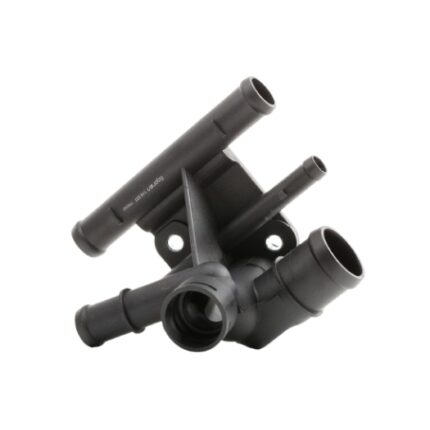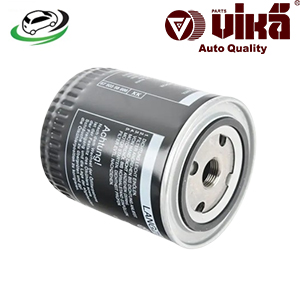Get VW Golf MK7/ Passat B8 Water Pump Thermostat Housing 06L121005A in Kenya
The water pump thermostat housing is an integral component of an internal combustion engine’s cooling system, playing a key role in maintaining the engine’s temperature and ensuring efficient operation. This housing not only serves as a protective case for the thermostat but also provides a connection point for the water pump, helping regulate coolant flow within the engine. Here’s an in-depth look at the water pump thermostat housing, its function, design, benefits, common issues, and maintenance.
1. Function and Role of the Water Pump Thermostat Housing
The water pump thermostat housing serves two primary functions within an engine’s cooling system:
- Protecting the Thermostat: The thermostat is a critical device that regulates coolant flow based on the engine’s temperature. The housing encases the thermostat, protecting it from damage, debris, and external elements while ensuring it operates accurately.
- Facilitating Coolant Flow: The housing acts as a junction point where the water pump, thermostat, and various coolant hoses meet. It ensures the smooth flow of coolant from the engine to the radiator and back, depending on the engine’s temperature needs. The thermostat inside the housing controls when the coolant is allowed to pass through to the radiator, based on temperature readings.
When the engine is cold, the thermostat remains closed, preventing coolant from flowing to the radiator. This allows the engine to reach its optimal operating temperature more quickly. Once the engine reaches the desired temperature, the thermostat opens, allowing the coolant to circulate through the radiator to be cooled before returning to the engine. The housing plays a crucial role in ensuring this process occurs efficiently and without leaks.
2. Design and Construction
The design of the water pump thermostat housing varies depending on the vehicle and engine configuration, but several common elements define its construction:
- Materials: The housing is typically made from durable materials such as aluminum, cast iron, or high-grade plastic. Aluminum and cast iron housings are known for their strength and resistance to high temperatures, making them ideal for heavy-duty and high-performance engines. Plastic housings, on the other hand, are lightweight and cost-effective but may be more susceptible to cracking or warping over time.
- Shape and Configuration: The housing is usually designed with multiple ports to connect the water pump, radiator hoses, and sometimes additional sensors or bypass valves. The shape and configuration ensure a secure fit onto the engine block or cylinder head and accommodate the specific routing of the coolant within the engine.
- Seals and Gaskets: To prevent coolant leaks, the housing is equipped with seals or gaskets that create a tight seal between the housing and the engine block. These gaskets are typically made from rubber or silicone, materials that can withstand the high temperatures and pressures within the cooling system.
- Mounting Points: The housing includes mounting points or flanges that allow it to be securely bolted to the engine. These mounting points ensure that the housing remains in place even under the vibrations and thermal stresses of engine operation.
3. Benefits of the Water Pump Thermostat Housing
- Temperature Regulation: The primary benefit of the thermostat housing is its role in regulating engine temperature. By housing the thermostat, it ensures that the coolant flow is controlled based on the engine’s needs, preventing both overheating and running too cold. This regulation is crucial for maintaining optimal engine performance and efficiency.
- Protection of the Thermostat: The housing protects the thermostat from external damage, such as impacts or debris, and from the harsh environment within the engine bay. This protection ensures that the thermostat can function accurately and reliably over time.
- Leak Prevention: A well-designed thermostat housing, with properly installed gaskets and seals, prevents coolant leaks at the critical junction between the water pump and the engine. This is essential for maintaining the correct coolant levels and preventing overheating.
- Durability: High-quality thermostat housings, especially those made from metal, are designed to withstand the rigors of engine operation, including high temperatures, pressure, and vibrations. This durability ensures long-term reliability and reduces the need for frequent replacements.
- Integration with Modern Engines: In modern engines, the thermostat housing often integrates additional features such as temperature sensors, bypass valves, or heater connections. This integration simplifies the design and improves the efficiency of the cooling system.
4. Common Issues and Failures
Despite its robust design, the water pump thermostat housing can experience issues that may compromise the cooling system’s effectiveness:
- Cracking and Warping: Plastic thermostat housings are particularly prone to cracking or warping over time, especially if exposed to extreme temperatures or if the coolant system is not properly maintained. Cracks can lead to coolant leaks, which can cause the engine to overheat.
- Leaking Seals and Gaskets: The gaskets and seals that prevent leaks between the housing and the engine block can degrade over time. Exposure to heat, pressure, and coolant can cause these seals to become brittle, leading to leaks.
- Corrosion: Metal thermostat housings, particularly those made from aluminum, can corrode over time, especially if the coolant is not regularly changed or if the cooling system is contaminated. Corrosion weakens the housing and can lead to leaks or complete failure.
- Stuck Thermostat: If the thermostat becomes stuck within the housing, either open or closed, it can lead to improper temperature regulation. A stuck-closed thermostat will cause the engine to overheat, while a stuck-open thermostat will prevent the engine from reaching its optimal operating temperature.
- Sensor Failures: In modern engines, the thermostat housing may house sensors that monitor coolant temperature or pressure. These sensors can fail due to exposure to heat and vibration, leading to inaccurate readings and potentially triggering warning lights or affecting engine performance.
5. Maintenance and Replacement
Proper maintenance of the water pump thermostat housing is crucial for the longevity and performance of the engine’s cooling system:
- Regular Inspection: Periodically inspecting the thermostat housing for signs of damage, such as cracks, warping, or corrosion, can help catch potential issues before they lead to more serious problems. Checking for coolant leaks around the housing is also important.
- Coolant System Maintenance: Keeping the cooling system in good condition is essential for the longevity of the thermostat housing. This includes regularly flushing and replacing the coolant to prevent contamination and corrosion and ensuring that the coolant mixture is correct for the engine.
- Replacing Seals and Gaskets: Over time, the seals and gaskets in the thermostat housing may need to be replaced. Doing so during routine maintenance or when replacing the thermostat can help prevent leaks and ensure a secure fit.
- Timely Replacement of the Housing: If the thermostat housing shows signs of significant wear, such as cracking or corrosion, it should be replaced promptly. Delaying replacement can lead to coolant leaks and potential engine overheating.
- Choosing the Right Replacement Part: When replacing the thermostat housing, it’s important to choose a part that matches the specifications of your vehicle. Using a high-quality replacement that is designed for your engine ensures a proper fit and reliable performance.
6. Importance in Modern Engines
In modern engines, the water pump thermostat housing plays an increasingly important role. As engines become more complex, with tighter tolerances and more sophisticated cooling requirements, the housing’s role in maintaining the proper coolant flow and temperature becomes even more critical.
For example, in engines with turbochargers or advanced emission control systems, precise temperature control is essential to prevent overheating and ensure optimal performance. The thermostat housing, by housing the thermostat and sometimes additional sensors or valves, helps maintain this delicate balance.
Furthermore, in hybrid and electric vehicles, where thermal management is crucial for both the engine and the battery system, the thermostat housing’s role extends beyond just the internal combustion engine, helping to regulate the temperature of multiple systems.
Follow us on Facebook for more parts.



